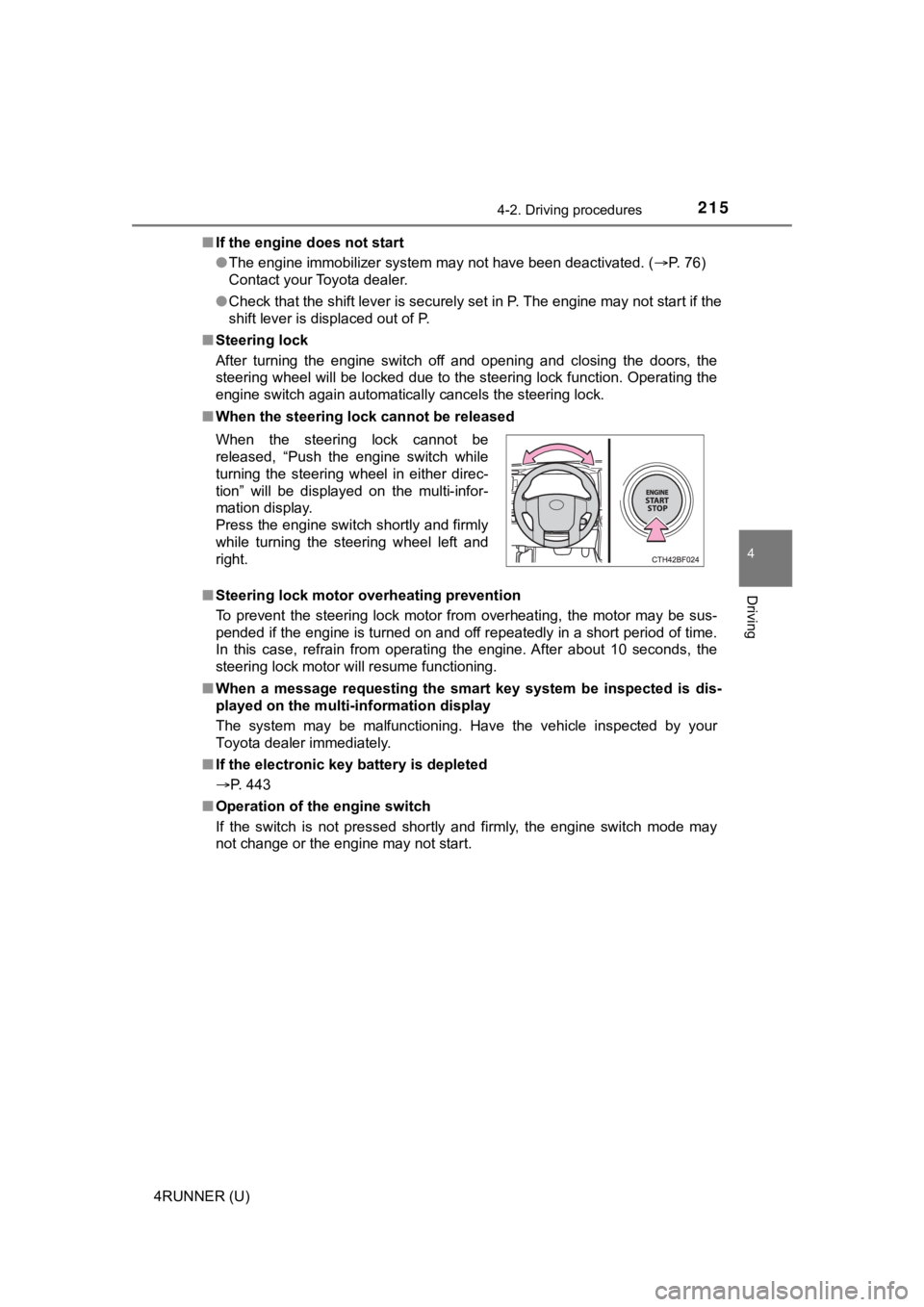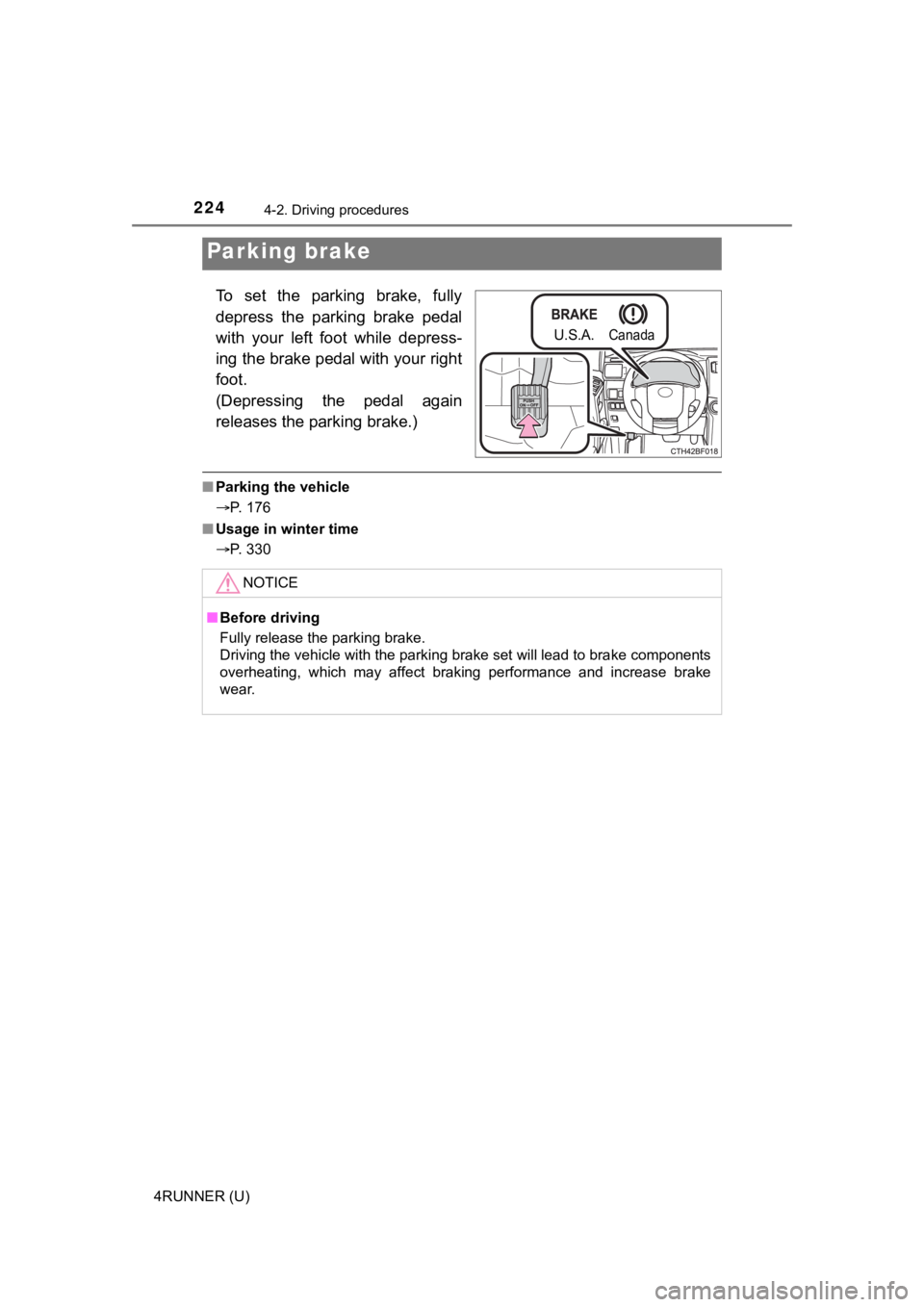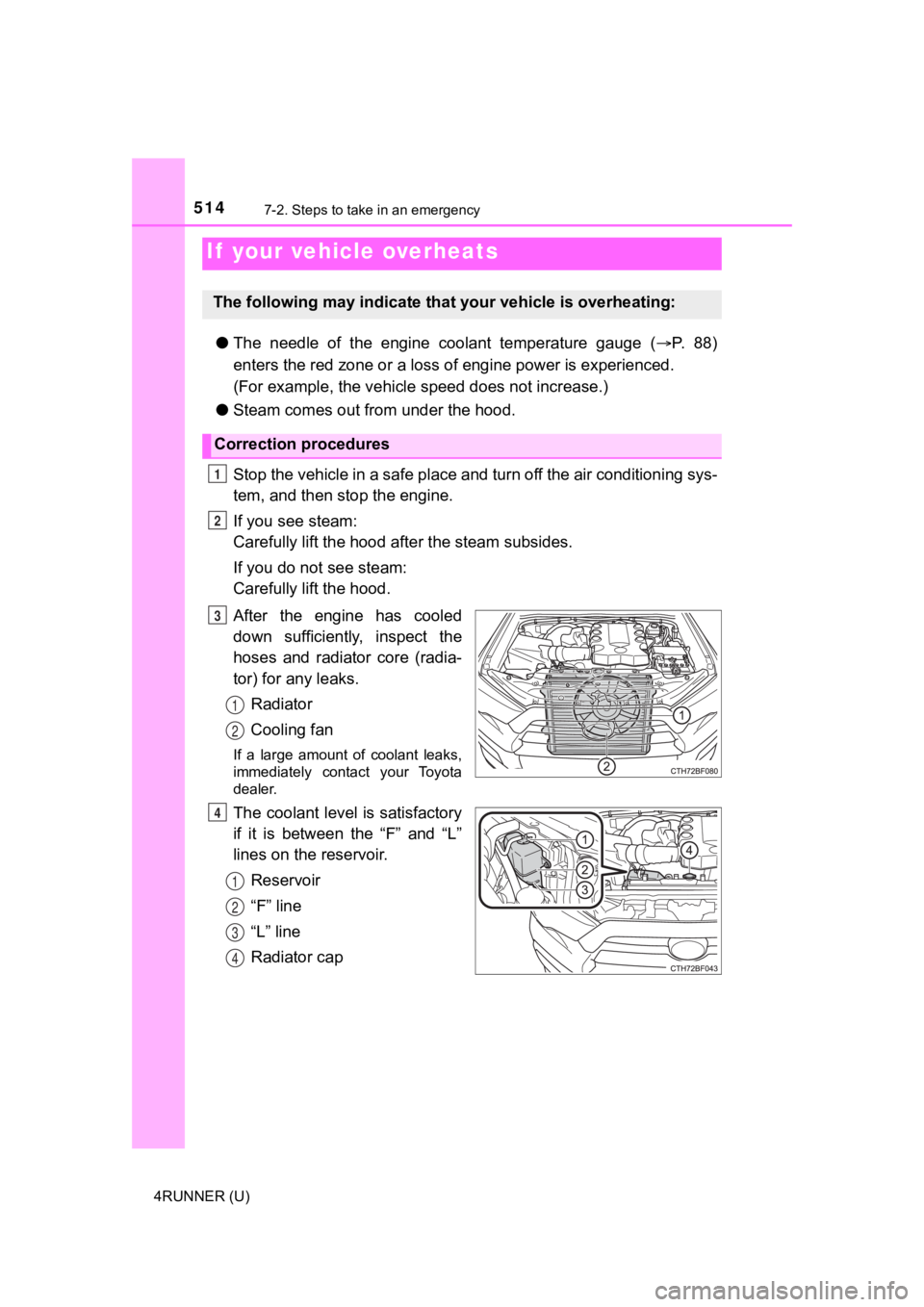2021 TOYOTA 4RUNNER overheating
[x] Cancel search: overheatingPage 89 of 592

892. Instrument cluster
2
Instrument cluster
4RUNNER (U)
Switches between odometer and
trip meter displays. When the trip
meter is displayed, pressing and
holding the button will reset the
trip meter.
The brightness of the instrumen t panel lights can be adjusted.
Brighter
Darker
■ The meters and display illuminate when
Vehicles without a smart key system
The engine switch is in the “ON” position.
Vehicles with a smart key system
The engine switch is in IGNITION ON mode.
■ The brightness of the instrument panel lights
When the headlight switch is turned to on, the brightness will be reduced
slightly unless the control dial is turned fully upward.
Changing the display
Instrument panel light control
1
2
NOTICE
■ To prevent damage to the engine and its components
● Do not let the indicator needle of the tachometer enter the red zone, which
indicates the maximum engine speed.
● The engine may be overheating if the engine coolant temperature gauge is
in the red zone (H). In this case, immediately stop the vehicle in a safe
place, and check the engine after it has cooled completely. ( P. 514)
Page 183 of 592

1834-1. Before driving
4
Driving
4RUNNER (U)
WARNING
Observe the following precautions.
Failure to do so may result in death or serious injury.
■When taking a nap in the vehicle
Always turn the engine off. Otherwise, if you accidentally move the shift
lever or depress the accelerator pedal, this could cause an acc ident or fire
due to engine overheating. Additionally, if the vehicle is park ed in a poorly
ventilated area, exhaust gases may collect and enter the vehicl e, leading to
death or a serious health hazard.
■ When braking
● When the brakes are wet, drive more cautiously.
Braking distance increases when the brakes are wet, and this ma y cause
one side of the vehicle to brake differently than the other sid e. Also, the
parking brake may not securely hold the vehicle.
● If the brake booster device does not operate, do not follow oth er vehicles
closely and avoid hills or shar p turns that require braking.
In this case, braking is still possible, but the brake pedal sh ould be
depressed more firmly than usual. Also, the braking distance wi ll increase.
● Do not pump the brake pedal if the engine stalls.
Each push on the brake pedal uses up the reserve for the power-assisted
brakes.
● The brake system consists of 2 individual hydraulic systems; if one of the
systems fails, the other will still operate. In this case, the brake pedal
should be depressed more firmly than usual and the braking dist ance will
increase.
If this happens, do not continue to drive the vehicle. Have you r brakes
fixed immediately.
Page 202 of 592

2024-1. Before driving
4RUNNER (U)
●Avoid jerky starts or sudden acceleration.
● Avoid jerky steering and sharp turns, and slow down before maki ng
turn.
● Note that when making a turn, the trailer wheels will be closer than
the vehicle wheels to the inside of the turn. Compensate by mak ing
a wider than normal turning radius.
● Slow down before making a turn, in cross winds, on wet or slipp ery
surfaces, etc.
Increasing vehicle speed can destabilize the trailer.
● Take care when passing other vehicles. Passing requires consider-
able distance. After passing a vehicle, do not forget the lengt h of
your trailer, and be sure you have plenty of room before changi ng
lanes.
● To maintain engine braking efficiency and charging system perfo r-
mance when using engine braking, do not put the transmission in
D.
● Instability happens more frequently when descending steep or lo ng
downhill grades. Before descending, slow down and downshift. Do
not make sudden downshifts while descending steep or long down-
hill grades.
● Avoid holding the brake pedal down too long or applying the bra kes
too frequently. This could cause the brakes to overheat and result in
reduced braking efficiency.
● Due to the added load of the trailer, your vehicle’s engine may over-
heat on hot days (at temperatures over 85°F [30°C]) when drivin g
up a long or steep grade. If the engine coolant temperature gau ge
indicates overheating, immediately turn off the air conditionin g (if in
use), pull your vehicle off the road and stop in a safe spot.
( P. 514)
Page 215 of 592

2154-2. Driving procedures
4
Driving
4RUNNER (U)■
If the engine does not start
●The engine immobilizer system may not have been deactivated. ( P. 76)
Contact your Toyota dealer.
● Check that the shift lever is securely set in P. The engine may not start if the
shift lever is displaced out of P.
■ Steering lock
After turning the engine switch off and opening and closing the doors, the
steering wheel will be locked due to the steering lock function. Operating the
engine switch again automatically cancels the steering lock.
■ When the steering lock cannot be released
■ Steering lock motor overheating prevention
To prevent the steering lock motor from overheating, the motor may be sus-
pended if the engine is turned on and off repeatedly in a short period of time.
In this case, refrain from operating the engine. After about 10 seconds, the
steering lock motor will resume functioning.
■ When a message requesting the smart key system be inspected is dis-
played on the multi-information display
The system may be malfunctioning. Have the vehicle inspected by your
Toyota dealer immediately.
■ If the electronic key battery is depleted
P. 443
■ Operation of the engine switch
If the switch is not pressed shortly and firmly, the engine swi tch mode may
not change or the engine may not start. When the steering lock cannot be
released, “Push the engine switch while
turning the steering wheel in either direc-
tion” will be displayed on the multi-infor-
mation display.
Press the engine switch shortly and firmly
while turning the steering wheel left and
right.
Page 224 of 592

2244-2. Driving procedures
4RUNNER (U)
To set the parking brake, fully
depress the parking brake pedal
with your left foot while depress-
ing the brake pedal with your right
foot.
(Depressing the pedal again
releases the parking brake.)
■Parking the vehicle
P. 176
■ Usage in winter time
P. 330
Parking brake
U.S.A.Canada
NOTICE
■Before driving
Fully release the parking brake.
Driving the vehicle with the parking brake set will lead to bra ke components
overheating, which may affect braking performance and increase brake
wear.
Page 319 of 592

3194-5. Using the driving support systems
4
Driving
4RUNNER (U)
■Multi-terrain Select is temporarily canceled when
The front-wheel drive control lever is shifted to H4 when Multi -terrain Select is
in ROCK, MOGUL or LOOSE ROCK mode. The mode indicator will flas h until
the lever is shifted back to L4.
■ If the Multi-terrain Select indicator continues to flash
This may indicate a malfunction in the Multi-terrain Select system.
In this case, Multi-terrain Select is automatically canceled. Have your vehicle
inspected by your Toyota dealer.
■ If the Multi-terrain Select indicator goes off while Multi-terr ain Select is
operating
● One of the vehicle systems related to Multi-terrain Select may be malfunc-
tioning.
Have your vehicle inspected by your Toyota dealer.
●
The brake actuator may be at risk of overheating.
A buzzer will sound, the “A-TRAC” indicator will go off and the “TRAC OFF”
indicator will come on. Stop the vehicle in a safe place. Refra in from using
Multi-terrain Select until the “A-TRAC” indicator comes back on and the
“TRAC OFF” indicator goes off. (The vehicle can still be driven , even if Multi-
terrain Select is inoperative.)
In the above cases, Multi-terrain Select is automatically cance led.
WARNING
■Before driving
To avoid an accident, observe the precautions relating to off-r oad driving.
( P. 333)
■ When using Multi-terrain Select
● Do not use the Multi-terrain Select system for normal (on-road) driving.
The Multi-terrain Select system is designed for off-road use on ly.
● Do not overly rely on Multi-terrain Select. This function does not extend
the vehicle’s performance limitations. Always check the terrain thoroughly
and drive safely.
● The recommended modes for the listed terrains ( P. 314) are only a refer-
ence. The selected mode may not be suitable to actual off-road conditions
due to factors such as the type or unevenness of the terrain or the degree
of incline. Check the actual terrain thoroughly and drive safel y.
● After selecting a mode, make sure that the Multi-terrain Select indicator
and the selected mode indicator come on. If any related indicator flashes,
the vehicle is not under Multi-terrain Select control.
Page 514 of 592

5147-2. Steps to take in an emergency
4RUNNER (U)
●The needle of the engine coolant temperature gauge ( P. 8 8 )
enters the red zone o r a loss of engine power is experienced.
(For example, the vehicle speed does not increase.)
● Steam comes out f rom under the hood.
Stop the vehicle in a safe place and turn off the air condition ing sys-
tem, and then stop the engine.
If you see steam:
Carefully lift the hood after the steam subsides.
If you do not see steam:
Carefully lift the hood.
After the engine has cooled
down sufficiently, inspect the
hoses and radiator core (radia-
tor) for any leaks. Radiator
Cooling fan
If a large amount of coolant leaks,
immediately contact your Toyota
dealer.
The coolant level is satisfactory
if it is between the “F” and “L”
lines on the reservoir.Reservoir
“F” line
“L” line
Radiator cap
If your vehicle overheats
The following may indicate that your vehicle is overheating:
Correction procedures
1
2
3
1
2
4
1
2
3
4
Page 581 of 592

581Alphabetical index
4RUNNER (U)
Child safety ................................ 52Airbag precautions .................. 37
Back door precautions .......... 133
Battery precautions ....... 418, 513
Child restraint system ............. 53
How your child should
wear the seat belt ................. 31
Installing child restraints ......... 57
Moon roof precautions .......... 173
Power window lock switch .... 162
Power window precautions ... 165
Rear door child-protectors .... 114
Removed electronic key battery precautions ...... 445
Seat belt extender precautions ........................... 34
Seat belt precautions .............. 56
Seat heater precautions........ 355
Child-protectors....................... 114
Cleaning ........................... 392, 395 Exterior ................................. 392
Interior................................... 395
Seat belts .............................. 396
Wheels and wheel ornaments .......................... 393
Clock ......................................... 373
Compass .................................... 92
Condenser ................................ 414
Console box ............................. 361
Cooling system Engine overheating ............... 514
Crawl Control ........................... 310
Cruise control Dynamic radar cruise control................................. 272
Cup holders.............................. 362
Curtain shield airbags ............... 35
Customizable features ............ 545 Daytime running light
system.................................... 228
Defogger Front windshield ................... 349
Outside rear view
mirrors ........................ 342, 349
Rear window ................. 342, 349
Dimension ................................ 520
Dinghy towing.......................... 208
Display Dynamic radar cruise control ................................ 272
LDA
(Lane Departure Alert) ....... 264
Multi-information display ......... 90
Trip information....................... 90
Warning message................. 484
Do-it-yourself maintenance .... 404
Door courtesy lights Wattage ................................ 529
Doors Automatic door locking
and unlocking system......... 115
Back door ............................. 131
Door lock ...................... 113, 132
Door windows ....................... 162
Open door warning buzzer ... 120
Open door warning light ....... 476
Outside rear view mirrors ..... 160
Rear door child-protector ...... 114
Side doors ............................ 110
Downhill assist control
system.................................... 307
Drive-Start Control .................. 177
Driver’s seat position memory .................................. 149D